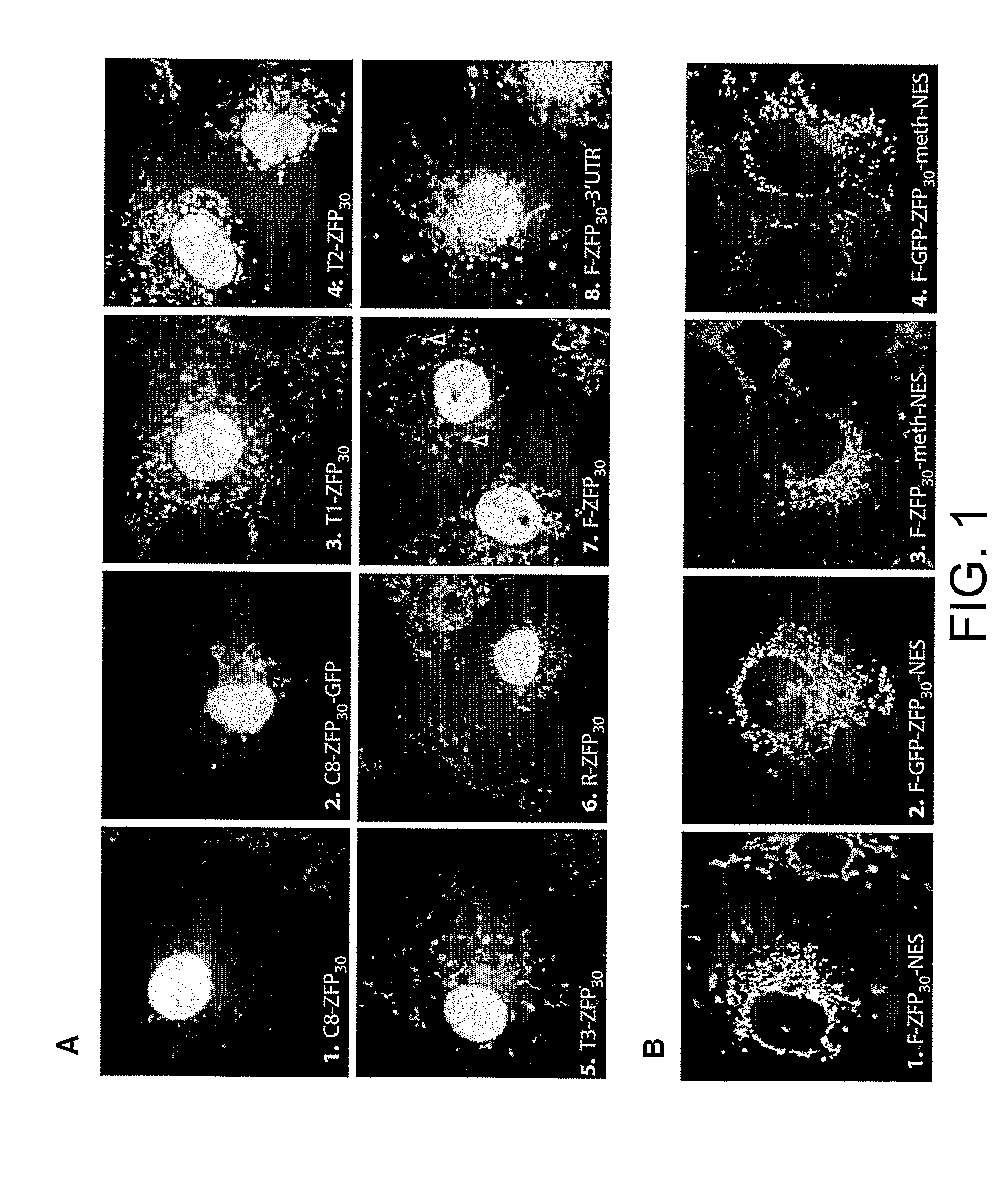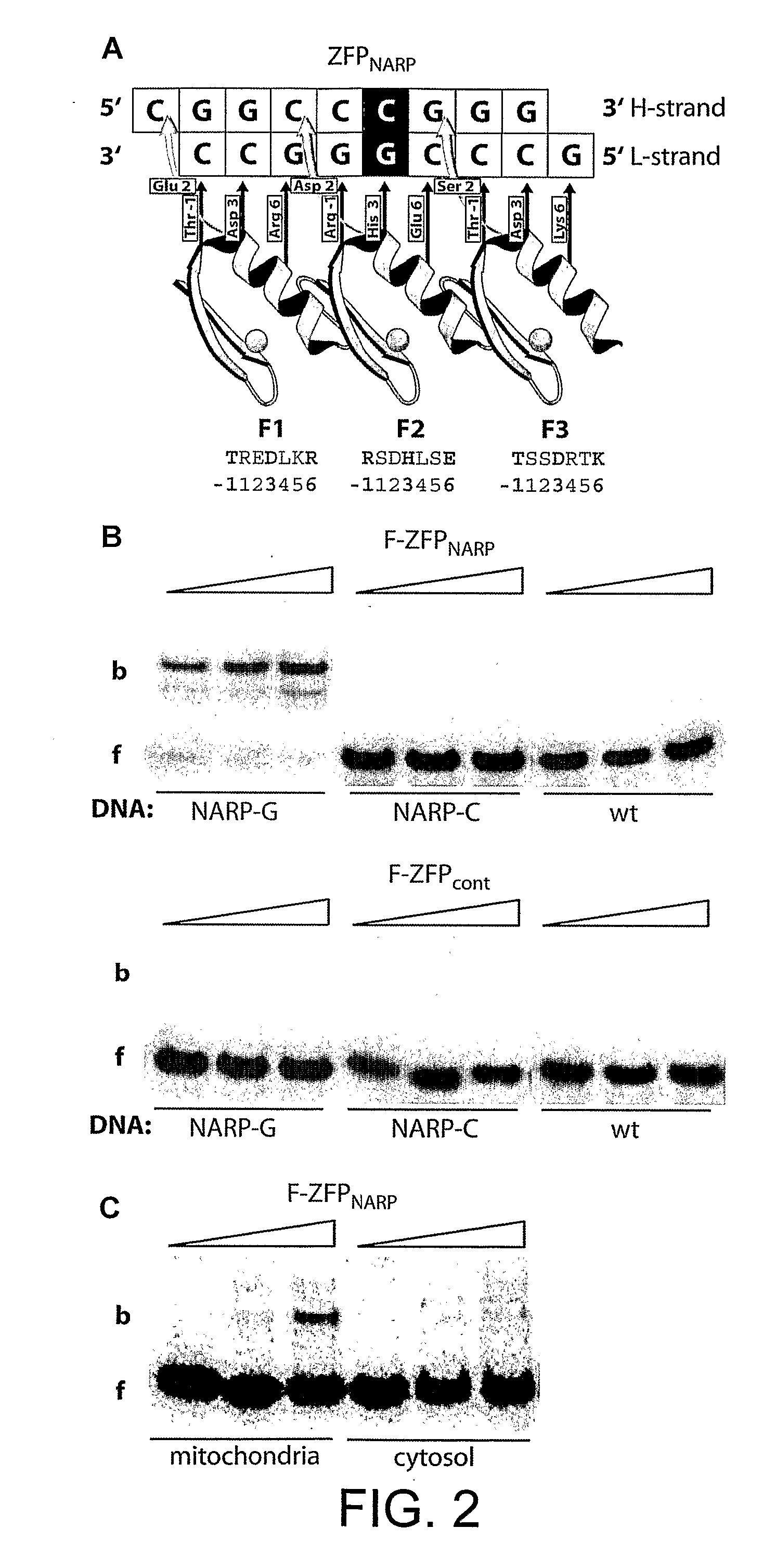Polypeptide targeting to mitochondria
a technology of polypeptides and mitochondria, applied in the direction of fusion polypeptides, peptide/protein ingredients, depsipeptides, etc., can solve the problem of insufficient use of mts
- Summary
- Abstract
- Description
- Claims
- Application Information
AI Technical Summary
Benefits of technology
Problems solved by technology
Method used
Image
Examples
example 1
Strategies for Delivering ZFPs to Mitochondria
[0235]Zinc fingers are predominantly DNA-binding proteins, evolutionary adapted to operate in the nucleus. Even in the absence of nuclear localisation signals (NLS) they often localise in the nucleus (Papworth, M., Kolasinska, P. & Minczuk, M. Gene in press (2005)). To use designer ZFP to manipulate mtDNA, they have to be both effectively targeted to mitochondria but also at the same time to be absent from the nucleus to avoid binding to nuclear DNA which could be toxic (specific examples discussed in Papworth et al. Proc Natl Acad Sci USA 100, 1621-6 (2003)). The majority of mitochondrial proteins are encoded by nuclear genes and imported from the cytoplasm with an aid of a cleavable N-terminal mitochondrial targeting sequence (MTS). The MTSs vary greatly in length and composition and appear to be individually tailored to different proteins (Pfanner, N. & Geissler, A. Nat Rev Mol Cell Biol 2, 339-49 (2001)). Fusing an MTS to N-termini c...
example 2
Construction of a Mitochondria-Targeted ZFP that Binds a Particular mtDNA Sequence
[0241]The next step was to generate ZFPs that bound selectively to particular mtDNA sequences. To this end we created a mitochondrially targeted 3-finger protein F-ZFPNARP designed to bind a 9 bp sequence GCCCGGGCC in mtDNA (FIG. 2A); the bold G is at position 8993 in mtDNA and indicates a mutation responsible for the mitochondrial diseases Neurogenic muscle weakness, Ataxia and Retinitis Pigmentosa (NARP) and maternally-inherited Leigh syndrome (MILS). The wild type (wt) sequence has a T at this position. In vitro FZFPNARP specifically bound an oligonucleotide containing GCCCGGGCC, as assessed by a gel retardation assay (FIG. 2B), In contrast, oligonucleotides containing either GCCCTGGCC (wt) or GCCCCGGCC were not bound by F-ZFPNARP (FIG. 2B). Additionally, in vitro binding studies of ZFPs showed that the addition of NES did not affect DNA binding (data not shown). A control, F-ZFPcont, of the same si...
example 3
Targeting a Chimaeric ZFP-Methylase to a Particular mtDNA Sequence
[0246]The next step was to investigate whether F-ZFPNARP could direct a DNA modifying activity selectively to the mutant GCCCGGGCC mtDNA sequence. As a DNA modifying activity we chose the catalytic domain of the human DNMT3a DNA methyltransferase. This enzyme predominately methylates cytosines in CpG sites to 5-methylcytosine (m5C), using S-adenosylmethionine (SAM) as a substrate. Chimaeric proteins comprising Zif268-derived ZFPs and the catalytic DNA methyltransferase domains have previously been shown to catalyse sequence specific DNA methylation in vitro (Xu, G. L. & Bestor, T. H. Nat Genet 17, 376-8 (1997); McNamara, A. R., Hurd, P. J., Smith, A. E. & Ford, K. G. Nucleic Acids Res 30, 3818-30 (2002)) and in vivo (Carvin, C. D., Parr, R. D. & Kladde, M. P. Nucleic Acids Res 31, 6493-501 (2003)). Endogenous cytosine methylation in human mtDNA is very limited (Shmookler Reis, R. J. & Goldstein, S. J Biol Chem 258, 90...
PUM
| Property | Measurement | Unit |
|---|---|---|
| Gene expression profile | aaaaa | aaaaa |
Abstract
Description
Claims
Application Information
 Login to View More
Login to View More - R&D
- Intellectual Property
- Life Sciences
- Materials
- Tech Scout
- Unparalleled Data Quality
- Higher Quality Content
- 60% Fewer Hallucinations
Browse by: Latest US Patents, China's latest patents, Technical Efficacy Thesaurus, Application Domain, Technology Topic, Popular Technical Reports.
© 2025 PatSnap. All rights reserved.Legal|Privacy policy|Modern Slavery Act Transparency Statement|Sitemap|About US| Contact US: help@patsnap.com



